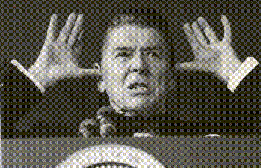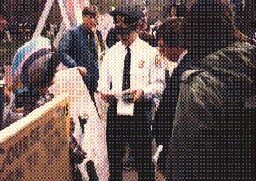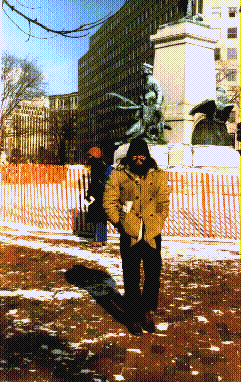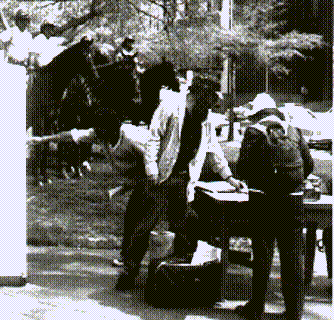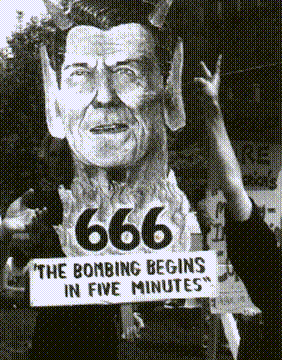Columnist Haynes Johnson
wrote about Thomas' sign, Wanted,
Wisdom & Honesty." St John's
Church on Lafayette Square, aka "the President's Church,"
gave a homily about peace and
tolerance which Mr. Bush unfortunately failed
to heed.
In addition to his hotly contested
adventure in Iraq, and his various
lies to the press (two lies we caught were the "Lafayette
Park Crack Scandal" of 1989, and "those
damn drums" of 1991, which continued to haunt
him in 1996), Mr.
Bush encouraged or permitted Department of Interior lawyers to
publish a fourth regulation
designed to further restrict demonstrators in Lafayette Park to
no more than "three cubic feet of property," including
literature and whatever is necessary to protect oneself from the
elements.

This
regulation remains on the books, impossible to abide by and survive
winter weather, and evoked by Park Police officers the week before
inauguration '97 to intimidate Concepcion and make all vigilers
very uncomfortable during bitter weather.
The uncaring attitude
which plagued the country for the decade of the '80's may be why
George Bush had only one inauguration.
Nevertheless, the damage was done. Regulations had become
so restrictive that all our fellow vigilers drifted away.

After Clinton
was elected, the Washington Times and Atlanta Journal published
friendly AP stories, "Anti-Nuke
Activists to Hold Their Line."
When inauguration ceremonies
were over, and most of the limousines
had vanished for another four years, Clinton's political
promises and Maya Anjelou's
poem ringing in our minds, we welcomed the Clintons into the
White House in 1993 by writing
a neighborly letter, advising them of the status
quo outside their front door, asking that they help rescind
the regulations which are threatening the vigil's existence. We
received a (friendly) form letter in reply, and a generally less
uncivil police force, for awhile.
However, the exceptions
have been very bad indeed, such as the tormenting and killing
of a homeless man in December '94, in part captured on tourist's
video and broadcast on worldwide TV.

The regulations haven't been rescinded.
And the status quo has
substantially changed for
the worse.
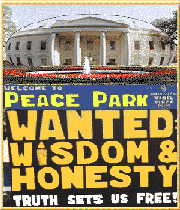
Thomas suggested the Secret Service put the White
House under a bubble,
instead of closing Pennsylvania Avenue. City
Paper was among those
who thought that a great idea.
Since Mr. Clinton's first parade, the vigilers have brought
a successful voter initiative
to the people of Washington DC, which has six times been introduced
to the House of Representatives by DC's Delegate Eleanor Holmes
Norton as the "Nuclear Disarmament
and Economic Conversion Act." The bill immediately
gained nine co-sponsors in
1994, but was stuck in committees. Ellen traveled in November
1994 to Japan, invited to speak
to 1,500 peace activists in 1994. The idea has enormous support
among people from all over the world.
In 1995 Ellen brought
a letter from Congresswoman
Norton to the International Court of Justice hearings
on the legality of nuclear weapons, which was accepted by
the judges as evidence that there were elected politicians within
the U.S. government who don't agree with the official policy of
"we've got 'em, we're keeping 'em, national sovereignty rules."
Although Congress and Mr. Clinton continued to drag their feet
on this issue (a "Comprehensive"
Test Ban Treaty doesn't go far
enough), the World Court
has found that nuclear weapons could and should be illegal. Sixty-two
retired generals in December
1996 declared nuclear weapons unsafe, unnecessary, and insane. One hundred former heads of state have called for global abolition of nuclear weapons, including Jimmy Carter. 85 per cent of Americans polled in 1998 favored abolition.
This is the good news.
The bad news is that under Clinton, Thomas was arrested twice in 1996, first
for merely speaking.  He was physically battered - blood
on the sidewalk - by a Secret Service officer on Easter
Eve, 1996, for reciting the Declaration of Independence when the officer
told him to stop talking. The prosecutors failed to prosecute.
Then, on election eve, 1996, Thomas was arrested by a Park Police
officer for NOT speaking. (Good
news is that he was acquitted after a farce of a trial).
He was physically battered - blood
on the sidewalk - by a Secret Service officer on Easter
Eve, 1996, for reciting the Declaration of Independence when the officer
told him to stop talking. The prosecutors failed to prosecute.
Then, on election eve, 1996, Thomas was arrested by a Park Police
officer for NOT speaking. (Good
news is that he was acquitted after a farce of a trial).
During the second Clinton administration, homelessness continued.
DOI Solicitors continued to change
the rules. We observed numerous
incidents where police officers
arbitrarily decided that lone demonstrators, preachers,
artists, musicians,
and even TV film crews, had to
stop what they were doing, leave
the park, or (yes!) move their stuff out of the park and into Pennsylvania Avenue. There seemed to be no logic or law to support some of the demands. Yet they usually prevail.
In 1999, at a one-of-a-kind, middle-of-the-night presidential drop-in, the Secret Service were told by President Clinton that the vigilers were "no threat." So far the new President Bush seems to feel the same way.
We heard rumors that Pennsylvania Avenue will reopen to vehicle traffic after the W Bush inauguration. Architect Carl Warnke, who redesigned Lafayette Park for Jaqueline Kennedy in the 1960's, has been asked by the Secret Service to do another redesign with a tunnel under the old street, and flowerbeds where police cruisers now lurk. He said to Ellen on June 2, 2001, that he hopes to create an historic atmosphere in and around the park, with people dressed in period costumes, horse-and-buggy rides, street theater, etc. - for and by the people. Perhaps this will happen. Whether or not, perhaps the police will be less inclined to behave as if they have exclusive domain. Perhaps George W. Bush will be tolerant. Perhaps you will help the new President, as well as the Representatives and Senators, to recognize the importance of protecting free expression outside the White House, and to seriously address the issues being raised by the vigilers day and night.
If we disappear, unless we've left because we've won our way, and nuclear weapons no longer exist on earth, and justice at last prevails, our disappearance from Lafayette Park would be an ominous sign indeed.
So if you're looking for us and don't find us, patrol the
whole park.
If you still don't see us, call (202-456-1111-0) or
write the White House and ask the President
to use his power to de-regulate and protect Lafayette (Peace)
Park, and tell the police and Department of Interior lawyers to "leave those
harmless peace vigilers alone."
Write us what you
think about it all!
1997 Inaugural Introduction | Park
Closures | Pennsylvania
Ave. Closure
Peace Park | Proposition
One
Legal Overview | Regulations
